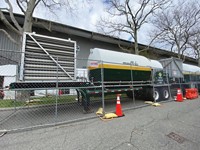Advertisement
Grab your lab coat. Let's get started
Welcome!
Welcome!
Create an account below to get 6 C&EN articles per month, receive newsletters and more - all free.
It seems this is your first time logging in online. Please enter the following information to continue.
As an ACS member you automatically get access to this site. All we need is few more details to create your reading experience.
Not you? Sign in with a different account.
Not you? Sign in with a different account.
ERROR 1
ERROR 1
ERROR 2
ERROR 2
ERROR 2
ERROR 2
ERROR 2
Password and Confirm password must match.
If you have an ACS member number, please enter it here so we can link this account to your membership. (optional)
ERROR 2
ACS values your privacy. By submitting your information, you are gaining access to C&EN and subscribing to our weekly newsletter. We use the information you provide to make your reading experience better, and we will never sell your data to third party members.
Environment
Arguing over the Safety of Fluorine
by JEAN-FRAN?OIS TREMBLAY, C&EN HONG KONG
June 27, 2005
| A version of this story appeared in
Volume 83, Issue 26
COVER STORY
Arguing Over The Safety Of Fluorine
Fluorinated compounds are used to clean critical instruments like chemical vapor deposition (CVD) chambers in semiconductor and liquid-crystal display (LCD) plants. At display plants, fluorine is both an expensive raw material and a challenging one because of toxicity and reactivity concerns.
Early on, the electronics industry opted to get its fluorine from hexafluoroethane. But the material is a greenhouse gas, and its use has faded. For nearly 10 years, the standard method of fluorine delivery to the CVD chamber has been nitrogen trifluoride, which is decomposed into fluorine and nitrogen immediately before use. The NF3 is made at a separate location.
Earlier this month, BOC Edwards announced that it is launching an on-site fluorine generator specially designed for the LCD industry. Noel Leeson, the firm's president of electronic materials for Asia, says safety and reliability are ensured by adding what seems like too many safety features to the machines.
Air Products & Chemicals, the largest supplier of NF3 to the electronics industry, does not offer such generators. To meet the demands of flat-panel makers, it recently expanded its facilities in the U.S. and is building an ammonia plant in South Korea, according to Corning F. Painter, regional vice president for electronics in Northeast Asia.
Painter warns that it is too hazardous to deliver fluorine gas to a CVD chamber. The best piping systems can leak, and there is a danger in storing the hydrogen fluoride that the generators require. The company's data show that fluorine is 2.5 times more toxic than chlorine gas. "F2 is also very reactive, so it requires special considerations to contain it," he adds. NF3, by comparison, is no more harmful than mothballs, according to Air Products.
BOC's Leeson says Air Products' response is understandable given that it has been investing large sums of money to expand its nitrogen trifluoride facilities. But he notes that the delivery of nasty gases to electronics manufacturers is commonplace, silane being a prime example.
Fluorine has been generated on-site for years for customers in the chemical and surface treatment industries, Leeson says. He acknowledges that an on-site generator in the electronics industry would likely be located several hundred meters from the CVD chambers. But the gas is delivered in a dual containment pipeline, with the inner pipe--about half an inch in diameter--carrying fluorine at low pressure, and the outer pipe carrying nitrogen at a higher pressure. He adds that in the unlikely event of a burst pipe, the generator will shut down, and only the fluorine contained between two auto-shutoff valves will leak out.
Leeson says fluorine delivery is a major focus for BOC Edwards. "In 20 years, you will see that every semiconductor and LCD plant will have its own on-site fluorine generator," he predicts.



Join the conversation
Contact the reporter
Submit a Letter to the Editor for publication
Engage with us on Twitter